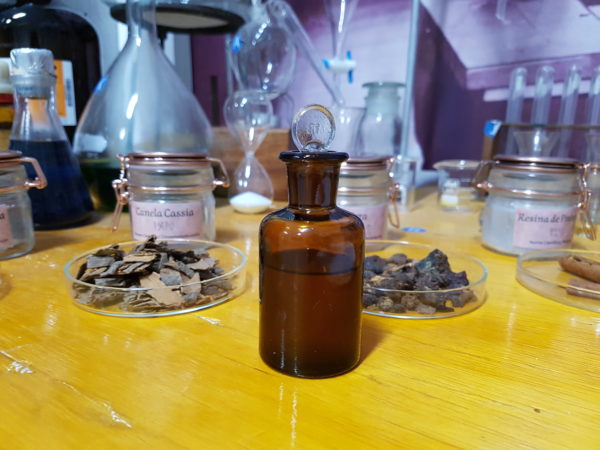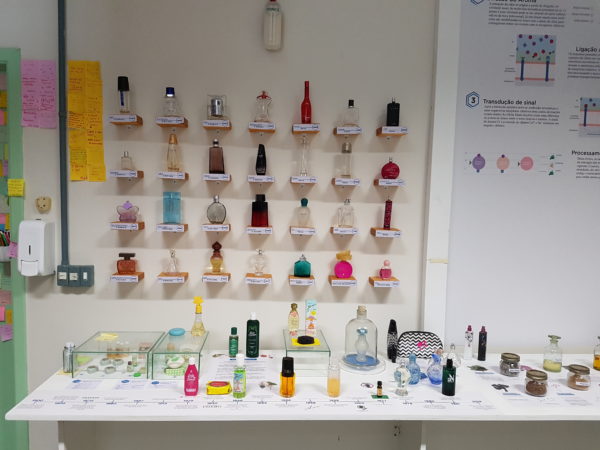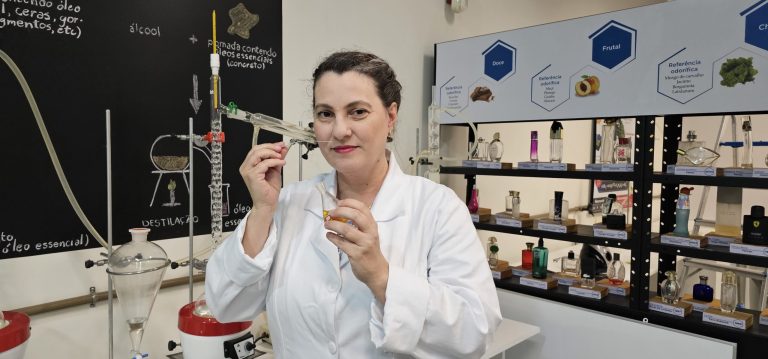São Paulo – The perfume of the iconic Queen Cleopatra, a nearly three-thousand-year-old scent from Ancient Egypt, was recreated by a researcher from the Scientific Dissemination of Chemistry Laboratory (Quimidex) of the Federal University of Santa Catarina (UFSC) in Southern Brazil. Anelise Regiani (pictured above), Professor and coordinator of Quimidex, told ANBA the compound is based on myrrh, pine resin and two types of cinnamon, ingredients that were highly valued in that historical period.
The fragrance is in Quimidex’s interactive exhibition on the chemistry of perfumes at UFSC’s Trindade campus in Florianópolis, and visitors can smell its unique aroma and scent the Egyptian royalty from the time of the pharaohs.
Cleopatra was born in 69 BC and reigned in Egypt between 51 BC and 30 BC; to this day, she is considered one of the most influential women of antiquity. In addition to her political skills, captivating personality and fascination with aromatic essences, Cleopatra is also remembered for her vanity.
The idea of reproducing the perfume arose based on a scientific paper published by German scientists in 2021 in the Near Eastern Archeology journal about archaeological finds in the Mendes (or Djedet) region, entitled “Eau de Cleopatra.”
Among the researchers was Dora Goldsmith, an Egyptologist specializing in the aromas of ancient Egypt. Her research was crucial to recreating the original formula. As perfume was a luxury reserved for high society at the time, it is possible Cleopatra herself was one of the fragrance’s users.

“Goldsmith pored over ancient literature, the writings of philosophers, went to several temples and read the hieroglyphs, and in this paper, she brings a possible formulation of Cleopatra’s perfume. In the paper, they say they are not sure because it is not written, but as it was a very famous perfume when she was alive, she probably knew and used it,” explained Regiani.
In September last year, the first reproduction of the perfume was made, which was exhibited during the university’s Teaching, Research, Extension and Innovation Week (Sepex). Recently, the fragrance was recreated again in a 50 ml bottle for the laboratory exhibition, accompanied by the inputs used so visitors can smell them individually.
“In addition to the perfume based on balanos oil, which was used at the time, we made a tincture, diluted in alcohol, because sometimes it is easier to smell the aromas,” said Regiani. The researcher revealed that the ingredients used were those found on the market and did not necessarily originate from the region.
Balanos oil comes from the fruits of the Balanites aegyptiaca tree, also known as Egyptian balsam, which are called desert dates – even though they are not dates, as they come from a tree, while dates come from a palm – from which the oil is extracted, for they are nearly odorless. To this day, Muslim Arabs have the custom of using oil-based fragrances.
The perfume called Mendesian refers to the origin of discoveries based on writings. Regiani said she did several tests until she came up with a formula that worked best and was simpler to make.

The researcher cooked the myrrh in balanos oil for one hour at 90°C, then added pine resin and cinnamon (Cinnamomum verum) and Chinese cassia (Cinnamomum cassia) were incorporated. Then, the compound was filtered and turned into a scented oil with a dry and fragrant hint, like a balm. “It’s spicy, woody, sweet; it’s delicious,” she said.
“Cleopatra was a woman with a significant presence to this day, and she had techniques to mark her presence so people would know she was there,” said Regiani. The teacher recalled a passage from the writings that exemplifies that. “The story goes that to get to Mark Antony [the Roman general who became her lover], in her first meeting with him, a seduction meeting, to seduce him, she would have scented the boat’s sails with the scent of roses, she arrived with a bang,” she joked.
And what would Cleopatra’s perfume be like today if she were a 21st-century woman? What perfume would she wear? “It definitely had to have myrrh, it had to be this balsamic, it had to have this cinnamon spice, but I believe it would be something with rose, something more rose-scented. And thinking it would be very modern, it had to be a sweet fragrance because that is in fashion today,” stated Regiani. “And perhaps with a citrus garnish, a bergamot, or lemon,” she added.
Regiani has been fond of perfumes since she was a child. She said she made sachets of fragrances to sell at school, and her father always gave her perfume for Christmas. From there, she studied the chemistry of perfumes and made it her career. Regiani said she has olfactory memories of several perfumes, but today, her favorite fragrances are those with orange blossoms.
The interactive exhibition has five modules: Chemical history of perfumery, Chemistry in the perfume bottle, Extraction of inputs, How we perceive smells, and History of perfumery in Brazil. Visits can be scheduled via email below.
Quick facts:
Interactive exhibition – The Chemistry of Perfumes
Quimidex – Laboratory for Scientific Dissemination of Chemistry of UFSC
Florianopolis, SC
www.quimidex.ufsc.br
@quimidex.ufsc
Visitation scheduling: quimidex.visitas@gmail.com
Translated by Elúsio Brasileiro




